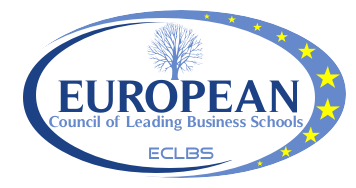KNU-history
Contact us
І. The establishment of Kyiv University and its pre-revolutionary operation during 1834-1917
1. Kyiv University during the first half of the 19th century
Taras Shevchenko National University of Kyiv is a research university with a classic tradition and is the leading establishment of higher education in Ukraine. Its history dates back to November 8, 1833, when its establishment was supported by C.C. Uvarov, then Minister of Education, who founded the Imperial University of Saint Volodymyr with the transfer to Kyiv of the Polish Kremenets High School. The inauguration of the university was on July 15, 1834, the Memorial Day of Saint Prince Volodymyr.
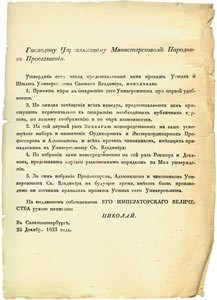 |
The Order of Nicholas I to the Ministry of National Education approving the draft statute and status of the University of Saint Volodymyr |
On 18 October 1834 Mykhailo Maksymovych, a 30-year-old Professor of botany, history, folklore and a prominent encyclopaedic academic, was appointed as the first Rector of the University by Emperor Nicholas I.
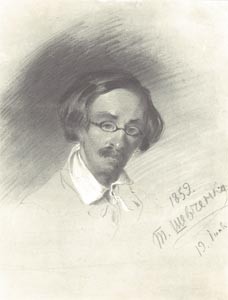 |
Portrait of M.O. Maksymovych by Taras Shevchenko (1845) |
During the 1834-1835 academic year only the Faculty of Philosophy was in operation at the university, with two Departments: History and Linguistics, and Physics and Mathematics. In the first year 62 students were enrolled and on 28 August 1834 the university commenced teaching. The Faculty of Law opened in 1835 opened, and in 1841 the Medical School was founded, based upon the Medical School of Vilensky University of Vilnius that had been shut down.
A major challenge for the university was the lack of its own premises. Its management was forced during the first eight years to rent a number of private buildings that had not been adapted for educational work. The construction of a new building commenced on 31 July 1837, designed by Vincent Beretti, Professor of Architecture at the St. Petersburg Academy of Arts.
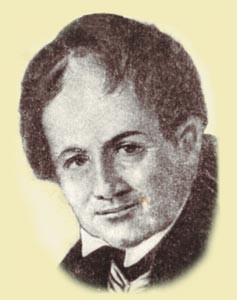 |
Vincent Beretti (1781-1842). Architect, academician, master of Russian classicistic architecture. Designer of university buildings and botanical garden. |
Under his direct supervision, the building was constructed in a classical style, and is today still used as the main building of the university. Meanwhile, Professor E. Trautfetter laid out the Botanical Gardens, which are still in use today. The transition to its own large building and the adoption in 1842 of the university charter permitted a continual growth in the scale of possible university Departments, and by this time the number of departments increased from 20 to 37.
Within the university's walls progressive ideas have always flourished and grown, despite the obvious desire of the imperial government to turn Kyiv University into an outpost of Russian autocracy. During the period 1830-1860 the university was one of the centres of the Polish national democratic movement, and during 1845 to 1847 the Cyril and Methodius Brotherhood was established and began to make its presence felt.
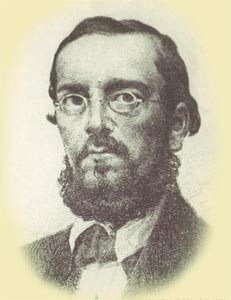 |
M.I. Kostomarov (1817-1885). Professor of Kyiv University, an eminent Ukrainian historian, ethnographer, writer, publicist and public figure. Instigator of the Cyril and Methodius Society and author of its charter. |
M. Kostomarov, a distinguished historian, was Head of the Department of Russian History at the university, and was creator and author of the credo of the Brotherhood. The intellectual inspiration for the Cyril and Methodius society members was the brilliant poet Taras Shevchenko, who at that time was working as a teacher of painting at the Art School of the University, while simultaneously holding a position in the university Archeography Commission (a temporary commission for the study of antique documents).
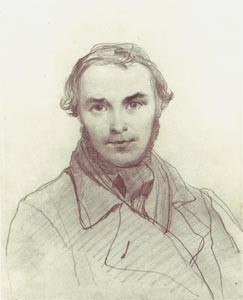 |
T.G. Shevchenko. Self-portrait. 1845 |
2. Kyiv University in the second half of the nineteenth century.
The revival of scientific and educational activity at Kyiv University in the second half of the nineteenth century resulted from the liberal reforms of the 1860s and the introduction in 1863 of a new university charter. At this time the right to act autonomously was extended at the university, which opened 15 new departments (increasing the number from 37 to 52), and increased the number of lecturers and students. 90 new lecturers were invited from Russian and European universities to work in Kyiv, and the departments began to keep talented students for academic research and educational activities.
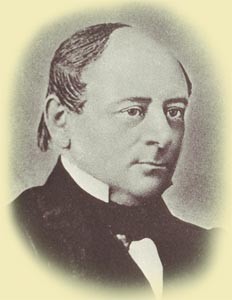 |
MD Ivanyshev (1811-1874). Professor, law historian, Rector (1862-1874). Editor-in-Chief of Kyiv Archaeological Commission publications |
By virtue of the reforms, by the late nineteenth century Kyiv University -became is a powerful teaching and educational centre of European importance. The number of students during the 1830s and 1840s was 500, mainly Poles, while by 1883 the University had 1700 students, mostly Ukrainian and Russian, and by 1913 this number had increased to 5000. Research and teaching work was provided by 160 professors and associate professors. The University had 45 teaching and ancillary facilities: including 2 libraries (academic and student), 2 observatories (both astronomical and meteorological), a botanical garden, 4 faculty clinics, 3 hospitals and 2 clinical departments at the City Hospital, a theatre of anatomy and 9 laboratories.
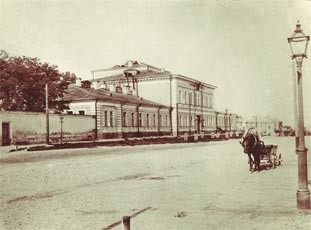 |
External view of the Anatomy building. Photo from the late nineteenth century. |
The lecturers and students were organized, active participants in a number of world-wide academic societies: naturalism, surgery, physics, mathematics, chemistry, and a history society named after Nestor the Chronicler.
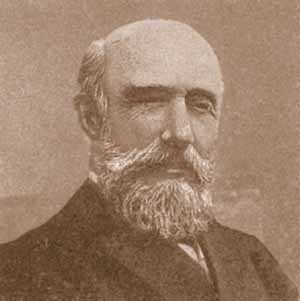 |
V.S. Ikonnikov (1841-1923). Professor, historian, academician of the Ukrainian Academy of Science (1920). One of the founders of the History Society named after Nestor the Chronicler. |
Academic activity by the professors was conducted in close collaboration with overseas research centres and prominent scientists around the world. There were frequent overseas research trips, with papers published in international journals and more. One aspect highlighting cultural relations was the election of distinguished academics and cultural figures as honorary members of the university. These included Doctor of medicine Max von Pettenkofer, historian Leopold von Ranke, author Ivan Turgenev, chemist Dmitri Mendeleyev, microbiologist Ilya Mechnikov, and others.
3. Kyiv University between 1900 and 1917
The history of the University at the beginning of the twentieth century was marked by the fact that the Ukrainian intelligentsia raised the issue of 'Ukrainianization' in higher education in the region. On 20 April 1906, representatives of the Ukrainian community in the city of Chernihiv (D. Yavorskiy, M. Kotsyubynskiy, M. Fedchenko, L. Shramchenko et al.) raised the issue of opening departments at Kyiv University for the study of Ukrainian language, literature, history, ethnography and common law, requesting that those subjects be taught in the Ukrainian language. On 22 May 1906, Professors V. Peretz and H. Pavlutskiy signed a submission to the Dean of the Faculty of History and Linguistics, which mandated that such Ukraine-oriented Departments be created .
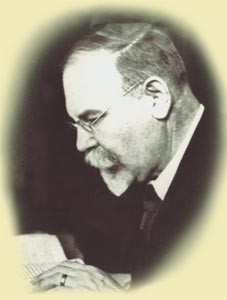 |
V.M. Peretz (1870-1935). Professor, literary historian, academician of the Ukrainian Academy of Science (1919). Supervised seminars of Russian Linguistics, and chaired the linguistics section of the Ukrainian Academic Society. |
Under their support a number of Ukrainian public and cultural figures emerged from the University of Kyiv: Ivan Lypa, Symon Petliura, Dmytro Doroshenko, Borys Hrinchenko, Oleksandr Lototsky, Mykhailo Hrushevsky, Serhiy Yefremov and others. 27 November 1906 saw Ukrainian students submit their applications to the Academic Council of the University to transfer to the newly-opened Ukraine-oriented Departments.
 |
M.S. Hrushevskiy (1866-1934). Distinguished Ukrainian historian, social and political activist, graduate of Kyiv University, Chairman of the Ukrainian Central Rada, the President of the Ukrainian People's Republic. Founder and Chairman of the Ukrainian Scientific Society. Academician of the Higher Ukrainian Academy of Science (1923) and the Academy of Science of the USSR (1929). |
1430 students signed such applications. However, the Rector of the University M. Tsytovych spoke out firmly against this idea, heading a reactionary group of professors and management from the Imperial Ministry of Education. In 1907, Professors A. Loboda and V. Perets on their own initiative began teaching Ukrainian literature at the University, until shortly this "seditious experiment" was banned.
The First World War severely disrupted the educational process. A considerable number of students found themselves conscripted into the army, the medical school of the University was transformed into a military hospital, and some of the laboratories under threat from the occupation of Kyiv by German and Austrian troops, were evacuated deep into the Empire, to the town of Saratov in southern Russia. They only returned to the University of Kyiv during the autumn of 1916. The moves resulted in serious losses to the laboratories, offices and museum collections of the University. Under such conditions, Kyiv University saw daily revolutionary activity, which in Ukraine was part of a struggle for cultural and national revival and the creation of an independent government.
 |
Lecture by Professor H.H. Pavlutsky in the office of fine art. Early 20th century. |
After the overthrow of the autocracy, insistent requests by Ukrainian students and lecturers gradually led to the opening of Ukraine-oriented Departments and the introduction of lecturing in the Ukrainian language, having compelled the new government in Petrograd to make a number of concessions. On 27 June 1917, the Ministry of People's Education had evolved their position to the point of opening at the University of St. Volodymyr four Ukraine-oriented Departments: Ukrainian Language, Literature, History and the history of Western Rus Law. On 5 September 1917 a proposal to that effect was submitted by the Ministry to the Provisional Government. 19 September 1917 saw the Government announce the establishment of the above-mentioned departments at Kyiv University. On 30 September 1917, the university administration ordered the undertaking of preparations to start work and recruitment for the Ukraine-oriented Departments, and this was given a time limit of no more than three months. However, by January 1918, when the three months had passed, the political events that unfolded in Ukraine pushed academic issues into the background.
II. Kyiv University during Soviet times 1917-1991
1. Kyiv University during the Ukrainian Revolution 1917-1919.
With the creation in Kyiv of the Central Rada in March 1917, dozens of lecturers and hundreds of university students took an active part in the struggle for the independence of Ukraine. The most heroic page in the history of independence was the story of the events involving students of Kyiv University, which took place at Kruty. In early January 1918 over three hundred university students and school students responded to a call by the leaders of the Ukrainian People's Republic in Kyiv and formed a student battalion. The first 130 volunteers under the command of a student leader, Andriy Omelchenko, led heavy defensive battles, protecting an important railway junction on 29 January 1918 - the Kruty station in the Chernihiv area - and holding back the offensive of Russian Bolshevik divisions on Kyiv.
In the period of the Ukrainian Hetman State, P. Skoropadskiy of the St. Volodymyr University obtained official status for the Russian University of Kyiv. At the same time, in July 1918, Kyiv Ukrainian National University was founded.
2. Break-up of the University into separate higher educational establishments 1920-1933
In February 1919 the Bolsheviks occupied the Kyiv University of St. Volodymyr and the Kyiv Ukrainian National University which they merged into one establishment, Kyiv University, with a main objective of educating the Soviet intelligentsia. The People's Commissariat of Education came into being in 1919 on the territory of Soviet Ukraine, responsible for the development of primary and secondary school education and higher education. In the universities, all so-called "bourgeois remains" were eliminated and all their autonomy was lost. The management structure of universities, such as the posts of Rectors and Vice- rectors was abolished and replaced by Commissars of Higher Education, and at this time all academic degrees and titles were abolished. The Soviet government set the goal of complete subordination of the university to the task of socialist revolution. However, even this very limited form of university had no right to exist, according to leaders of the People's Commissariat of Education of the Ukrainian Soviet Socialist Republic. They were branded as centres for the "bourgeoisie", which had no place in the new communist society.
 |
Chemistry lecture |
As a result of these reforms in 1920 Kyiv University (along with other universities in Ukraine) was disbanded. A separate Medical Institute was created from the remains of the Medical Faculty, and the Faculty of Law was transferred to the Institute of People's Economics. The Drahomanov Institute of Higher People's Education was formed from the Faculties of history and linguistics, physics and mathematics and natural science, together with the Kyiv Teacher Training College and the Kiev Institute of Higher Women's Courses. In 1926 this was renamed as the Kyiv Institute of People's Education (KIPE). The number of Ukrainian students in the Institute reached 65%.
 |
Training teaching staff to eliminate illiteracy in the Workers' Faculty of the KIPE. |
As a result of pivotal reform, higher education in the Ukrainian Soviet Socialist Republic began to differ fundamentally from high school in Soviet Russia. Russian universities lost much of their essential value, but were not disbanded and continued to function in Moscow, Leningrad and other Russian cities. Unification was one of the most important targets in Soviet education policy in the 1920s and 1930s, and it became necessary to rebuild the whole system of higher education on a single Russian model.
 |
Students in the "Soviet Red Corner" of a university dormitory, 1930s |
The absence of traditional university education at this time led to a drop in the number of scientists and qualified teaching staff, the loss of educational and academic traditions at universities and falling standards across higher education, as for the entire period after the closure of universities, there was no equivalent replacement. It became altogether obvious that the Soviet authorities were unable to organize the functions of higher educational establishments, not having the knowledge base and experience from pre-revolutionary higher education.
 |
Participants in a mathematics seminar held by Academician D.O. Grave, 1930 |
3. Re-establishment of Kyiv University and its pre-war operation 1933-1941
In autumn 1933, universities were re-established in Ukraine, including the Kyiv State University. Before them lay the task of putting students through postgraduate centres to train lecturers for high schools, together with producing scientists for research institutes, scientific laboratories in factories, and scientific research stations. These universities needed to focus on academic training for all major branches of science.
 |
Students in a university dormitory. 1934 |
In 1934 the University celebrated its 100th anniversary. At that time its structure was renewed, and research and teaching activities recommenced. In 1935 the University began to publish a series of academic journals on the natural sciences and humanities. New Faculties were formed and by 1938 there were eight: physics and mathematics, history, linguistics, chemistry, geology and geography, biology, law and foreign languages. In March 1939, in honour of the 125th anniversary of the birth of Taras Shevchenko, the Presidium of the Supreme Soviet of the USSR conferred the title of Kyiv State University on the institution. In the same year, the Kaniv Bio-Geographical Reserve was transferred to the university, giving it a scientific-experimental and educational centre for the Faculties of Natural Science. The following year a new building was opened for the Humanitarian Faculties (now the Maksymovych Academic Library Building).
 |
Students at Kiev State University. 1936 |
The massive repression of lecturers and students was a heavy blow to the University during the 1930-40s. Among the lecturers lost during the repression were the academics: M.P. Kravchuk, N.Y. Mirza-Avakyants, M.O. Rusanivsky, K.T. Shteppa, M.I. Bezborodko, and A.Y. Krimsky, together with many others.
However, despite the ideological restrictions and repression, on the eve of World War II, Kyiv University was among the leading universities of the USSR, ranked in third place among Soviet universities. 4,000 students were studying there, with more than 300 professors, associate professors and lecturers working in 52 departments. Among these were 8 Academicians and 6 Corresponding Members of the Academy of Science of Ukraine, 24 PhDs and 65 lecturers with higher academic degrees. Postgraduates at the University became highly qualified in 43 disciplines.
 |
Meeting of the Academic Council at the newly restored Kyiv University. 1934 |
When hostilities began in the summer of 1941, Kyiv University was evacuated. The majority of students went to the Front, while many lecturers, together with colleagues from Kharkiv State University, continued the learning process at the United Ukrainian State University in Kazakhstan, in the city of Kyzylorda. Simultaneously, attempts were made to continue some of the work of the university in Nazi-occupied Kyiv, but soon the Nazis closed the university, repressed most of the lecturers, and students were taken as forced labour to Germany. During the battles that took place in Kyiv during October-November 1943, the University suffered irreparable damage and loss.
 |
Liberation by Soviet soldiers at the walls of the burnt-out Kyiv University. 1943 |
The main "Red" building of the University suffered considerable, where the library, museum collections and laboratories were looted. The cost only of the laboratory equipment lost reached the colossal sum of 50 million Karbovanets (Soviet roubles) .
4. Kyiv University during the post-war period 1944-1991
Despite the enormous losses during the war, the post-war decades saw the main university of Ukraine manage to not only restore its lost potential, but also substantially strengthen. Immediately after the liberation of Kyiv, the revival of the university began. Students and lecturers rebuilt the Humanities and Chemistry buildings with their own hands and by 15 January 1944, classes resumed for senior undergraduates and for first-years on 1 February. 146 students, 3 professors, 7 associate professors and 11 lecturers from the Kyiv unit of the United Ukrainian State University returned from Kyzylorda in the summer of 1944. Nearly 1,500 young men and women enrolled for the 1944-45 academic year, and within a year they were joined by another 2,000 students. It was possible to reopen 80 departments, with 290 professors, associate professors and lecturers. By 1946 there were over 3,800 students, taught by 357 professors and lecturers at the university.
 |
International students at Kyiv University just after the war. 1947. |
At the end of the 1940s, the scope of work at the University was reaching pre-war levels. There was especially rapid development of the university during the 1950s. Up to 1958 the Kyiv State University has 11 faculties and almost 10,000 students. During the 1959 to 1984 period, 70 thousand students graduated from the University, moving into various sectors of the economy, science, education and culture.
 |
Public address by M.U. Biliy, Rector of the University, celebrating Shevchenko Day in 1981. |
Over the years hundreds of prominent academic have worked at Kyiv University, including:
- Historians and Linguists: M. Maksymovych, V. Tsikh, F. Dombrovski, I. Neykirkh, M. Kostomarov, P. Pavlov, V. Antonovych, V. Ikonnikov, I. Luchytsky, M. Drahomanov, V. Peretz, M. Dovnar-Zapolzky, M. Dashkevych, A. Loboda, F. Volk, F. Fortynsky, Y. Kulakovsky, S. Yefremov, A. Krymsky, A. Hermayze, Y. Tarle, N. Polonska-Vasilenko, A. Ohloblin;
- Philosophers: O. Novitsky, A. Hilyarov, H. Chelpanov, V. Shynkaruk;
- Lawyers: K. Nevolin, M. Ivanishev, M. Vladymyrsky-Budanov, A. Kistyakivsky;
- Economists: H. Sydorenko, M. Sieber, M. Yasnopolsky, P. Kovanko;
- Mathematics and Mechanics: I. Rakhmaninov, M. Vashchenko-Zakharchenko, P. Romer, V. Yermakov, D. Hrave, O. Schmidt, B. Bukreyev, H. Pfeifer, H. Suslov, P. Voronets, M. Boholyubov;
- Physicists: M. Avenarius, M. Schiller, J. Kosonohov;
- Chemists: H. Fonberg, M. Bunhe, S. Reformatsky, A. Babko, A. Holub, A. Pylypenko, A. Kipriyano;
- Geologists: K. Feofilaktov, V. Chyrvynsky, M. Andrusov, P. Tutkovsky, V. Tarasenko;
- Botanists: V. Besser, E. Trautfetter, O. Rohovych, I. Schmalhausen, S. Navashyn, K. Puriyevych, O. Fomin, Y. Baranetsky, M. Kholodny, N. Kornyushenko, D. Zerov, O. Lypa;
- Zoologists: K. Kessler, O. Kovalevsky, O. Severtsov, O. Korotnyev, S. Kushakevych, L. Shelyuzhko, B. Mazurmovych;
- Biochemist: O. Palladin;
- Medical Doctors: V. Karavayev, O. Walter, V. Bets, M. Sklifosovsky, F. Yanovsky, V. Obraztsov, V. Chahovets, M. Strazhesko and other prominent academics.
ІІІ. Kyiv University in independent Ukraine
On 21 April 1994, Taras Shevchenko National University of Kyiv was granted the status of "National" by Leonid Kravchuk, the President of Ukraine by Decree № 176/94, and on 25 November 1999 a further Decree № 1496/99 of Leonid Kuchma, now President of Ukraine, significantly expanded the autonomous status of the university. Decree № 412/2008, of Viktor Yushchenko, President of Ukraine, on 5 May 2008, further stipulated the conversion of the University to becoming the main principal educational and scientific centre of Ukraine for the education of academic and teaching staff with higher qualifications. Then on 29 July 2009 the Cabinet of Ministers of Ukraine with Regulation № 795 granted the University the status of being a self-governing and autonomous national research university, while providing increased funding for the future development of the university.
 |
The main building of Taras Shevchenko National University of Kyiv |
The University awards Junior Specialist’s, Bachelor’s, Specialist’s and Master’s degrees, Higher Qualification Post-graduate degrees and Doctoral degrees. Training and retraining programs are provided in 14 specialties of Junior Specialist qualification, 55 fields of Bachelor training programs, 49 areas of Specialist training programs and 98 fields of Master training programs. More than 26 thousand students study at the University. Approximately 1,645 postgraduate students and 125 PhD students are working for higher qualifications at the University. Courses are provided by 198 Departments, who have more than 80% of their teaching staff with academic degrees of Doctor or at a Higher Postgraduate level, and over 50% of the teaching staff has attained the academic rank of professor or associate professor.
There are 13 Faculties within the University: Geography, Economics, History, Cybernetics, Mathematics and Mechanics, Sociology, Faculty of Information Technology, Radio Physics, Electronics and Computer Systems, Psychology, Physics, Philosophy, Chemistry, Law. There are 8 Institutes (the Military Academy, the High Technology Centre, the Institute of Geology, the Institute of Journalism, the Institute of International Relations, the Postgraduate Education Centre, the Institute of Linguistics, and the State Security Department) and 1 Training and Research Center (the Institute of Biology), 2 Colleges (Optical and Mechanical College, Geological Exploring College) and Ukrainian Physical and Mathematical Lyceum.
 |
L.V. Hubersky, Rector, with Honorary Doctors at Taras Shevchenko National University of Kyiv 2009 |
Taras Shevchenko National University of Kyiv has a number of auxiliary facilities: Astronomical Observatory, the Fomin Botanical Garden, the Maksymovych Academic Library, the Kaniv Nature Reserve, a publishing and reprographics unit called "Kyiv University", an Informatics Centre, a Ukrainian Studies Centre, a Geological and Zoological Museum, a Museum of the History of the University, an interfaculty Museum of Linguistics, and others.
 |
Graduates of Taras Shevchenko National University of Kyiv |
Today the University has bilateral partnership agreements with 227 foreign educational and scientific institutions from 57 countries. 180 foreign academics and lecturers from 32 countries visit the University annually to collaborate in research, attending conferences, and giving lectures. Each year more than 1500 lecturers, researchers and students travel abroad to 59 countries. Two-thirds of those take overseas trips in 2014 travelled abroad for academic purposes (conferences, training, and research).
Today Taras Shevchenko National University of Kyiv is a classical university with a research profile, whose primary objectives are education, research and innovation.






